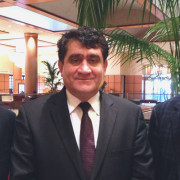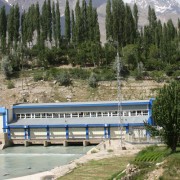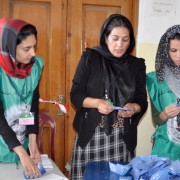 At a women’s business center in Khandood, locals meet over a knitting enterprise. Rural electrification helps women to complete daily chores in less time, allowing them more time with friends and relatives.
Aga Khan Foundation/Andrew Quilty
At a women’s business center in Khandood, locals meet over a knitting enterprise. Rural electrification helps women to complete daily chores in less time, allowing them more time with friends and relatives.
Aga Khan Foundation/Andrew Quilty
 At a women’s business center in Khandood, locals meet over a knitting enterprise. Rural electrification helps women to complete daily chores in less time, allowing them more time with friends and relatives.
Aga Khan Foundation/Andrew Quilty
At a women’s business center in Khandood, locals meet over a knitting enterprise. Rural electrification helps women to complete daily chores in less time, allowing them more time with friends and relatives.
Aga Khan Foundation/Andrew Quilty
One morning last May, 100 residents of two isolated communities in Afghanistan gathered with a handful of representatives of the governments of the United States, Tajikistan and Afghanistan, and the Aga Khan Development Network. Together they celebrated the end of a journey connecting their villages to the power grid. For the citizens of Deshor and Wiriz, it marked the start of a new era.
For the first time, the new transmission lines crossing the border from Tajikistan brought reliable electricity, with associated social and economic opportunities to these communities high in the Afghan Pamir Mountains. It changed life for over 400 Afghan households—nearly 3,000 people—and, through infrastructure upgrades, improved the availability of reliable electricity for another 20,000 people.
Pamir Energy—a partnership of the Government of Tajikistan, the Aga Khan Fund for Economic Development and the International Finance Corporation—worked with USAID and the Aga Khan Foundation USA to extend transmission lines across the Panj River, which serves as much of the Afghan-Tajik border, into Afghanistan’s Shugnan district. Through the partnership, Pamir Energy upgraded facilities and trained Afghan utility workers to maintain the new lines and improve the region’s infrastructure.
“All of this allows us to further our mutual goal of increased regional trade and cooperation” in Central Asia, said Leslie M. Hayden, former U.S. chargé d’affaires in Tajikistan, at a ceremony last May. “It’s our partnership and cooperation that drive the success of our work.”
The power lines heralded new opportunities for those living among the valleys and canyons of the remote mountain range that cuts across the Afghanistan-Tajikistan border. World Bank studies show that access to reliable electricity provides a major boost to local economies, increasing rural household incomes by about 30 percent and improving water and food security. What’s more, energy investment—combined with parallel investments in bridges, markets and roads—fosters regional trade and economic development throughout all of Central Asia.
“I’m glad that our previous and ongoing projects promote energy cooperation in the region,” Hayden said, referring to the Economic and Social Connections Global Development Alliance in Tajikistan, “and facilitate the development of small-scale commercial enterprises.”
In a sense, Hayden was preaching to the choir. Many residents had stories about the benefits. Shahnaz*, a midwife and nurse in the district, described the life-and-death impact she saw in the clinic where she works. Before the power lines, she said, many babies died in their first 10 days of life. Since the clinic was connected to the new source of power, however, every baby delivered, she added, “has been healthy and properly looked after. This is thanks to the availability of electricity in our delivery room.”
Other residents pointed to the transformation at home. “We have lights!” said Isfandiyori, another Shugnan resident. “And instead of daily trips to the mountains with our children to collect firewood for cooking and baking, we now have an electric oven, which just needs to be plugged into an outlet.”
Davlatmoi, Isfandiyori’s wife, emphasized how electricity access has transformed education for her family. “It is very, very important to see our sons and their wives on the internet, and our younger sons and daughters having the opportunity to go to school year-round, where they enjoy their studies in warm and well-lit classrooms,” she said.
Davlatmoi added, “We also bought an iron, electric kettle …. [W]e watch TV and our children study and use the computer. Baking bread, cooking food and boiling water do not require hard work from us or our children. Now we can focus effort on other things.”
Surmounting a Mountain of Challenges
Electricity did not come easy for the people of Shugnan.
At over 9,500 feet above sea level, the communities lie many hours of hard driving from the district capital in Ishkashim, which is itself a full day’s drive from Kabul. The solution involved USAID, an international partnership and local initiative.
Daler Jumaev, CEO of Pamir Energy, says that community mobilization is always an important part of energy projects, but this time was exceptional. “It was surprising,” he said of how much communities were eager to help, hauling heavy materials on narrow paths over steep mountain passes and digging holes for the transmission line poles.
This eagerness was particularly extraordinary given that the new lines would also mean new costs to the residents. Yet the residents were more than willing to pay. Years before in Tajikistan, said Jumaev, the utility ran a big campaign to get Tajik customers—who, as part of the former Soviet Union, were used to the government paying the cost of electricity—accustomed to the consumer mindset of paying their own electric bill. Afghan residential customers needed no such prodding, and an average family pays about $4.23 (283 Afghan afghani) monthly. “Residential customers on the Afghan side served by PE [Pamir Energy] always pay their bills on time,” he said.
Linking the two countries’ electrical grids also involved technical hurdles. Connecting Tajik-standard voltage power lines to voltage lines on the Afghan side of the border required more power lines and additional “step-down” transformers to align the different voltage power lines of the two countries.
Jumaev cited cross-border impact at both the regional and local levels. Local construction has increased, with more houses dotting the landscape and enhanced government services. Along with this growth, he said, comes an obligation for infrastructure to keep up: “We have to be ready today to meet future demands.”
“Energy cooperation between Tajikistan and Afghanistan can promote economic development within regions with new or more secure electricity supply,” agreed Daler Asrorov, a project management specialist in USAID/Tajikistan’s economic growth office. This project, he said, shows the real benefits of cross-border linkages.
Extending access to electricity is also one of the most effective ways to improve livelihoods. It enables people to invest in new businesses, creates jobs, increases incomes, and gives people a stake in a more stable and peaceful neighborhood.
The experience echoes trends across Asia. “Cross-border energy trade is now becoming a reality in South Asia as well,” says Aditi Mukherji, a human geographer and theme leader with the International Centre for Integrated Mountain Development in Nepal.
Mukherji pointed to the Bangladesh-Bhutan-India-Nepal agreement for cross-border energy. Now Nepal imports nearly 200 megawatts of electricity from India via transmission lines made possible by joint investment.
“Technically, once all transmission lines and grids are harmonized, importing and exporting electricity becomes routine,” she said. The countries see the value of regional energy trade. “This is one sector where we are likely to see a lot more regional integration,” she added.
USAID’s partnership with Aga Khan and Pamir Energy continues well beyond the cables across the Panj. A feasibility study is exploring expansion of Pamir Energy power generation capacity with a new, 11-megawatt plant. The proposed Sebzor hydropower plant will enable the electrification of 391,000 Afghans, connect a further 50,000 Tajiks to the main grid, and resolve all winter deficits in five to 10 years. It will anchor the grid in a disaster-prone area of Tajikistan and reduce vulnerability in harsh terrain.
*For their security, Afghan community members are identified by first name only.
David Taylor is a communications officer with the Aga Khan Foundation USA. The foundation and the Aga Khan Fund for Economic Development are part of the Aga Khan Development Network.
Related Links
Two Towns, One Power Station
USAID has witnessed success in more than one remote landscape in Afghanistan. The Agency also supported the construction of a small power station, completed in 2015 in the Wakhan corridor, a narrow strip of land in northern Afghanistan sandwiched between Tajikistan, Pakistan and China. The Multi-Input Area Development Global Development Alliance, a five-year, $96 million partnership between USAID and the Aga Khan Development Network, funded the project.
The effort was driven by two communities—Chelkand and Sarhad-I Broghil. They worked together to build a microhydro station, which converts energy from a flowing stream to usable electricity, supplying enough power for hundreds of households. (A 100-kilowatt station can serve 100 to 120 households.) Aditi Mukherji with the International Centre for Integrated Mountain Development says that “sometimes remote mountain communities may be better served by isolated microgrids than by national power grids.”
One resident, Dewana Baig, explained how he used to pay steep prices for diesel to light his home. Often his family couldn’t afford to light more than one corner of the house for a few hours at dinner. They went to bed early. Even though they had had a limited supply of diesel, the exhaust posed a health hazard to everyone living in his house. Now, he says, his family feels as if they are living in a completely different world: “We have television, which makes us aware of news and developments in our country and around the world.”
In 2013, a feasibility study identified this area as the most suitable location for a microhydro station. Residents formed a group for station management and pooled their energies to excavate the canal and turbine location, collected stones for construction, unloaded sand and gravel, and helped to install the equipment. They formed a maintenance committee and a community energy fund—another critical component for keeping the lights on. And two locals learned the electrical skills necessary to maintain the plant.
Since opening in 2015, the plant has provided electricity to households, schools and clinics in Chelkand and Sarhad-I Broghil, and has energized small-scale industries including grain mills, bakeries and carpentry shops. Electrification has provided jobs for women and young people, and light for students’ studies.
“Now that we have electric power, I bought a computer for my daughter,” says Mir Jan. “I believe that electric power will bring many positive changes in our lives, especially in education.”














Comment
Make a general inquiry or suggest an improvement.